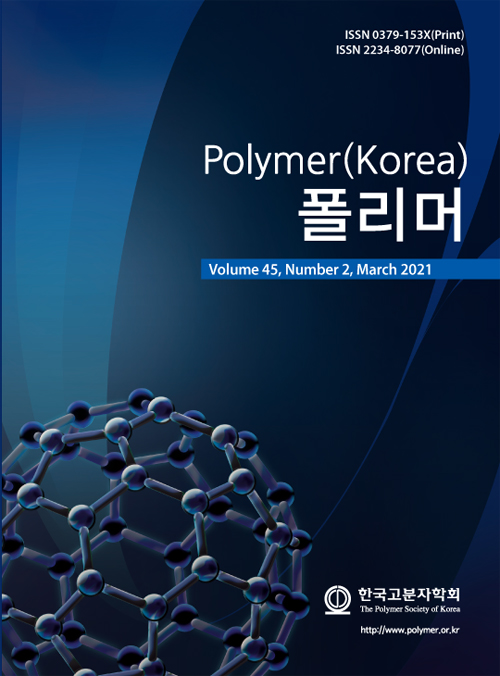- Effects of Electron-beam Irradiation on Electrical and Mechanical Properties of Conductive PEDOT:PSS/Silane Aerogels
School of Chemical Engineering and Materials Science, Chung-Ang University, Seoul 06974, Korea
- 전자선 조사에 의한 전도성 PEDOT:PSS 에어로젤의 전기적 및 기계적 물성 변화 연구
중앙대학교 화학신소재공학부
Reproduction, stored in a retrieval system, or transmitted in any form of any part of this publication is permitted only by written permission from the Polymer Society of Korea.
We prepared polymer aerogels based on a conducting polymer, poly(3,4-ethylenedioxythiophene) polystyrene sulfonate (PEDOT:PSS), and silane precursors, such as tetraethylorthosilicate (TEOS) and (3-glycidyloxypropyl)trimethoxysilane (GOPS), and investigated their specific resistance and stress–strain behaviors as a function of electron-beam dose. PEDOT:PSS/silane aerogels were easily made by homogenizing and freeze-drying from the aqueous mixtures. The composite aerogels were irradiated by the high-energy electron beams with a dose ranging from 1 to 50 kGy. Solvent vapor treatment was also used to see the effects of irradiation on the properties of the resulting aerogels. The resistance of high-conductivity aerogels increased when irradiated. PEDOT:PSS/TEOS aerogels became stiffer when irradiated, whereas PEDOT:PSS/GOPS samples peaked the stiffness at 1~5 kGy. Different behaviors were likely from two competitive mechanisms of chemical scission and cross-linking caused by electron beams
전도성 고분자 복합체 PEDOT:PSS에 실란 전구체인 TEOS 또는 GOPS를 혼합하여 고분자 에어로젤을 제작하고, 전자선 조사 공정에 따른 비저항과 스트레스-스트레인 특성을 연구하였다. PEDOT:PSS/실란 에어로젤은 혼합 수분산액의 균질화와 동결 건조를 통해 제작하였으며, 복합체 에어로젤에 대한 전자선 조사선량은 1에서 50 kGy까지 달리하였다. 용매 증기 처리를 통해 전도도를 향상시킨 에어로젤의 저항은 전자선 조사에 따라 증가하였다. PEDOT:PSS/TEOS 에어로젤은 전자선 조사에 따라 경직성이 증가하는 경향을 보였으나, PEDOT:PSS/GOPS 샘플은 경직도가 1~5 kGy에서 최대를 보였다. 이러한 경향 차이는 전자선 조사에 의한 공유결합 절단과 가교 기작의 경쟁에 따른 것으로 보인다
Keywords: conducting polymer, polymer-silane composite, hybrid aerogel, electron beam, strain-stress behavior
- Polymer(Korea) 폴리머
- Frequency : Bimonthly(odd)
ISSN 0379-153X(Print)
ISSN 2234-8077(Online)
Abbr. Polym. Korea - 2023 Impact Factor : 0.4
- Indexed in SCIE
 This Article
This Article
-
2021; 45(2): 246-252
Published online Mar 25, 2021
- 10.7317/pk.2021.45.2.246
- Received on Oct 18, 2020
- Revised on Nov 4, 2020
- Accepted on Nov 8, 2020
 Correspondence to
Correspondence to
- Felix Sunjoo Kim
-
School of Chemical Engineering and Materials Science, Chung-Ang University, Seoul 06974, Korea
- E-mail: fskim@cau.ac.kr










 Copyright(c) The Polymer Society of Korea. All right reserved.
Copyright(c) The Polymer Society of Korea. All right reserved.